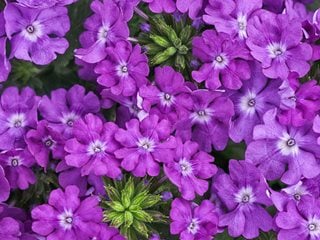How To Grow And Care For Verbena Plants
Verbena plants, also known as vervain, are a group of flowering plants that are known for their colorful and fragrant blossoms. They are popularly used as bedding plants, as well as edging and border plants. They are also often grown in containers and hanging baskets. Verbena plants are easy to care for and can thrive in a variety of climates. With proper care, these plants can bloom all summer long and provide colorful and fragrant blooms for many years to come. When it comes to growing and caring for verbena plants, there are a few key tips to keep in mind. These include providing them with adequate sunlight, watering them regularly, and fertilizing them. With these practices, you can enjoy a beautiful and vibrant garden of verbena plants.
Overview of Verbena
Verbena is an attractive perennial flower that is often used in gardens, landscapes, and even containers. This hardy plant can be found in a variety of colors and sizes, making it a popular choice for gardeners. It is a low-maintenance, drought-tolerant plant that can thrive in a variety of climates. Verbena is also known for attracting beneficial insects such as butterflies and bees. With its beautiful blooms and easy-to-care-for nature, verbena is an excellent choice for gardeners of all levels.
When growing verbena, it is important to provide the plant with enough sunlight, water, and nutrients. The soil should be well-draining and rich in organic matter. The plant should be watered regularly, and the soil should be kept moist but not soggy. Fertilizer can be added in spring and midsummer for best results. Pruning can help keep the plant in shape and encourage new growth. Deadheading can also help the plant to produce more flowers. Proper care and attention will ensure that verbena plants remain healthy and blooming.
Growing Verbena from Seed
Growing Verbena from seed can be an economical and rewarding way to add this popular garden perennial to your garden. When starting Verbena from seed, it is important to purchase quality, viable seed from a reliable source. To ensure successful germination, the seeds should be planted in well-draining soil that has been amended with aged compost or manure. Before planting, the soil should be lightly tilled or broken up to create a loose, airy environment for the seeds to thrive in. Plant the seeds 1/8-inch deep in the soil, and keep the soil consistently moist until the seedlings emerge. It is best to keep seedlings indoors or in a sheltered area until they are at least four inches tall and the last frost date has passed.
Once the seedlings have been transplanted outdoors, they should be placed in an area that receives full sun. The soil should be kept consistently moist and should be fertilized every two weeks with a balanced 10-10-10 fertilizer. Verbena should be deadheaded regularly to encourage new blooms and to keep the plants looking their best. To prevent the spread of disease, it is important to avoid overhead watering and to remove any dead or wilted leaves or flowers from the plants. With proper care and maintenance, Verbena plants can provide vibrant, colorful blooms for many years.
Planting Verbena in the Garden
Verbena is an evergreen perennial flower that adds beauty and color to any garden. Planting verbena in the garden is easy and rewarding. To get started, make sure your soil is well-draining and amended with compost or other organic matter. Select a location that has plenty of sun and good air circulation. Plant your verbena in the ground or in containers, spacing them 12-18” apart. Water regularly to keep the soil consistently moist. To promote more blooms, trim the plants back to the ground after the first bloom cycle. To prevent pests and diseases, use a preventive fungicide and insecticide as directed. When it comes to companion planting, verbena looks great when mixed with other flowering plants like petunias and impatiens. With proper care and maintenance, verbena plants will reward you with colorful blooms all season long!
Caring for Verbena Plants
Verbena plants are a beautiful addition to any garden. Although they are relatively easy to grow and maintain, they do require some specific care in order to thrive and stay healthy. Knowing how to care for Verbena plants is essential for keeping these vigorous and vibrant plants happy and healthy.
Watering is one of the most important aspects of caring for Verbena plants. These plants require regular watering, especially during the hotter months of the year. Make sure to avoid over-watering, as this can lead to root rot and other serious issues. It is best to water your Verbena plants in the morning, as this gives them the opportunity to absorb the water before the heat of the day.
In addition to watering, Verbena plants also require plenty of sunlight. They thrive best in full sun, so make sure to place them in a spot that provides them with plenty of direct sunlight. If your Verbena plants aren’t getting enough sun, they may become pale and weak.
Fertilizer is also key for keeping Verbena plants healthy. It is best to fertilize your Verbena plants at least once a month throughout the growing season. Use a balanced fertilizer with equal amounts of nitrogen, phosphorus, and potassium.
Finally, pruning is also essential for Verbena plants. You should prune them regularly to encourage strong, healthy growth. Prune them back to shape and cut away any dead or damaged branches. This will help your Verbena plants to stay healthy and vibrant.
By following these simple tips, you can ensure that your Verbena plants stay healthy and thrive in your garden. With the right care and attention, Verbena plants can become a beautiful and vibrant addition to any outdoor space.

Common Problems with Verbena Plants
Verbena plants are generally easy to care for but there are a few common problems you should be aware of. Verbena plants are susceptible to root rot and fungal diseases if they are overwatered or planted in poorly drained soil. To prevent these problems, make sure to provide sufficient drainage, water only when the top inch of soil feels dry and avoid overhead watering. Verbena plants are also prone to aphids and spider mites. To protect them, inspect your plants regularly for signs of infestation, and use insecticidal soaps or neem oil to treat any infestations. Lastly, Verbena plants may be attacked by leaf miners, which are small larvae that feed on the leaves of the plant. To reduce the risk of leaf miner damage, use floating row covers to protect the plants. With these simple tips, you can ensure that your Verbena plants are well cared for and remain healthy.
Propagating Verbena
One of the most rewarding ways to enjoy Verbena is to propagate the plant. Propagating Verbena plants can be done through division, cuttings, or seed.
Verbena can be divided during the early spring, when the plant is actively growing. To start, dig up the entire plant and divide the root clump into several sections. Each section should have a few healthy stems and roots attached. Plant these sections in separate pots filled with soil and water them immediately.
Alternatively, you can propagate Verbena by taking cuttings from a healthy plant. Make sure to use a sharp, clean knife to take cuttings from the stems, then place them in a container filled with water. When the roots have grown, transfer the cuttings into individual pots or directly into your garden.
Lastly, you can also grow Verbena from seed. Plant the seeds directly into soil, or start them indoors 6-8 weeks before the last frost date. Make sure to keep the soil consistently moist and in a location that gets plenty of sunlight.
No matter which propagation method you choose, Verbena is a beautiful addition to any garden. Once established, Verbena plants require minimal maintenance and will bring joy and color to your garden for years to come.
Harvesting Verbena
Verbena plants are one of the most popular flowering plants, due to their vibrant blooms and diverse range of colors. They are also incredibly easy to care for, and are a great way to add a bright burst of color to any garden. Once they have bloomed, harvesting verbena is a great way to enjoy its blooms for longer.
Harvesting verbena is simple and can be done as soon as the flowers have fully opened. Carefully cut the stem just above the lowest leaf to keep the plant healthy. Make sure to use sharp, clean shears or scissors to avoid damaging the stems. After cutting, immediately place the flowers in a vase of water to keep them looking their best.
Verbena is a great addition to any garden, and harvesting its blooms is a great way to make the most of it. As long as you follow the steps above, you’ll be able to enjoy the beauty of verbena for much longer. With the addition of some proper care and maintenance, you can ensure that these plants will bloom for years to come.
Using Verbena in Landscaping
Verbena plants are not only beautiful, but they are also incredibly versatile and can be used to create stunning landscapes. From a single plant to a large display, verbena can be used to create an array of different looks. When used in landscaping, verbena plants require minimal maintenance and are drought tolerant. They also attract beneficial pollinators such as butterflies and bees, making them a popular choice for gardeners.
Verbena is incredibly easy to grow; it can be planted directly into the soil or in containers. Verbena plants can be planted in sunny locations with well-draining soil. They require regular watering to ensure they remain healthy and vibrant. When planting in containers, be sure to use a quality potting mix and provide adequate drainage. Container plants should also be fertilized every month or two to ensure they remain healthy and vibrant.
Verbena plants are incredibly hardy and require minimal maintenance. Deadheading, or removing dead or dying flowers, will help encourage new growth and ensure the plant remains vibrant. Pruning is also important; verbena should be pruned in the spring and fall to encourage new growth and make sure the plant stays healthy.
Verbena plants are incredibly versatile and can be used to create stunning landscapes. From a single plant to a large display, verbena can be used to create an array of different looks. With minimal maintenance and the ability to attract pollinators, verbena plants are a great choice for any garden.
FAQs About the How To Grow And Care For Verbena Plants
1. What is the best way to water Verbena plants?
A: The best way to water Verbena plants is to water them thoroughly, but not too often. You should allow the top inch or two of soil to dry out before watering again.
2. What kind of light does Verbena need?
A: Verbena plants need at least 6 hours of direct sunlight per day. If you can provide more sunlight, your Verbena will thrive and bloom more.
3. How often do I need to fertilize Verbena plants?
A: You should fertilize your Verbena plants every 2-3 weeks during the growing season. You can use a balanced liquid fertilizer or a slow-release fertilizer.
Conclusion
Verbena plants are an attractive and versatile addition to any garden or landscape. They are easy to care for and are drought tolerant, making them ideal for those who do not have a lot of time to devote to gardening. With proper care, they will thrive and bloom for many years. With its vibrant flowers and attractive foliage, verbena plants make an excellent choice for any garden.





